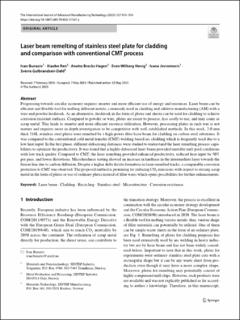| dc.contributor.author | Bunaziv, Ivan | |
| dc.contributor.author | Ren, Xiaobo | |
| dc.contributor.author | Hagen, Anette Brocks | |
| dc.contributor.author | Hovig, Even Wilberg | |
| dc.contributor.author | Jevremovic, Ivana | |
| dc.contributor.author | Gulbrandsen-Dahl, Sverre | |
| dc.date.accessioned | 2024-04-23T14:26:29Z | |
| dc.date.available | 2024-04-23T14:26:29Z | |
| dc.date.created | 2023-05-23T13:24:19Z | |
| dc.date.issued | 2023 | |
| dc.identifier.citation | The International Journal of Advanced Manufacturing Technology. 2023, 127, 911-934. | en_US |
| dc.identifier.issn | 0268-3768 | |
| dc.identifier.uri | https://hdl.handle.net/11250/3127825 | |
| dc.description.abstract | Progressing towards circular economy requires smarter and more efficient use of energy and resources. Laser beam can be efficient and flexible tool for melting different metals, commonly used in cladding and additive manufacturing (AM) with a wire and powder feedstock. As an alternative, feedstock in the form of plates and sheets can be used for cladding to achieve corrosion resistant surfaces. Compared to powder or wire, plates are easier to process, less costly to use, and may come as scrap metal. This leads to smarter and more efficient resource utilization. However, processing plates in such way is not mature and requires more in-depth investigation to be competitive with well-established methods. In this work, 2.0 mm thick 316L stainless steel plates were remelted by a high-power fibre laser beam for cladding on carbon steel substrates. It was compared to the conventional cold metal transfer (CMT) welding-based arc cladding which is frequently used due to a low heat input. In the first phase, different defocusing distances were studied to understand the laser remelting process capabilities to optimize the productivity. It was found that a highly defocused laser beam provided unstable melt pool conditions with low track quality. Compared to CMT, the laser remelting provided enhanced productivity, reduced heat input by 50% per pass, and lower distortions. Microhardness testing showed an increase in hardness in the intermediate layer towards the fusion line due to carbon diffusion. Despite a higher delta ferrite formation in laser-remelted tracks, a comparable corrosion protection to CMT was observed. The proposed method is promising for reducing CO2 emissions with respect to reusing scrap metal in the form of plates or use of ordinary plates instead of filler wires which opens possibilities for further enhancements. | en_US |
| dc.language.iso | eng | en_US |
| dc.publisher | Springer Nature | en_US |
| dc.rights | Navngivelse 4.0 Internasjonal | * |
| dc.rights.uri | http://creativecommons.org/licenses/by/4.0/deed.no | * |
| dc.title | Laser beam remelting of stainless steel plate for cladding and comparison with conventional CMT process | en_US |
| dc.title.alternative | Laser beam remelting of stainless steel plate for cladding and comparison with conventional CMT process | en_US |
| dc.type | Peer reviewed | en_US |
| dc.type | Journal article | en_US |
| dc.description.version | publishedVersion | en_US |
| dc.rights.holder | © The Author(s) 2023. Published by Springer Nature. | en_US |
| dc.source.pagenumber | 911-934 | en_US |
| dc.source.volume | 127 | en_US |
| dc.source.journal | The International Journal of Advanced Manufacturing Technology | en_US |
| dc.identifier.doi | 10.1007/s00170-023-11567-y | |
| dc.identifier.cristin | 2148733 | |
| dc.relation.project | Norges forskningsråd: 237900 | en_US |
| dc.relation.project | Norges forskningsråd: 269898 | en_US |
| cristin.ispublished | true | |
| cristin.fulltext | original | |
| cristin.qualitycode | 2 | |

